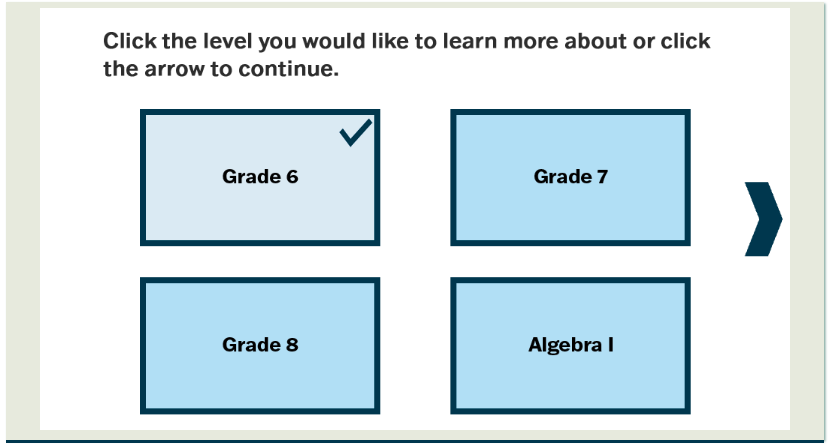Situation – Recognizing a Common Concern
In my role at a curriculum company that develops professional development courses for K-12 teachers, I was well aware of a persistent issue with our most popular courses. These general courses, which served as an introduction to our curriculum, were met with a consistent complaint from educators – they lacked grade-level-specific content. 28% of survey responses echoed this concern, making it the most prevalent feedback.
Task – Developing Systems to Create More Relevant Content
Determined to address this challenge, I set out to transform our general courses into resources that felt more pertinent and relevant to our learners. My primary objective was clear: I wanted our teachers to engage with content that directly related to their specific grade levels, ultimately providing a more meaningful learning experience.
Action – Two Ways to Present More Relevant Content
To tackle this issue, I implemented a two-pronged approach.
Grade-Level Branching: I introduced grade-level branching within our interactive elements and course structure. This solution allowed learners to seamlessly access information tailored to their grade level, ensuring that the content they encountered was aligned with their classroom realities.
Grade-Level Thought Partners: In addition to branching, I worked with our learning experience design team manager to enlist the assistance of grade-level thought partners. These were experienced teachers, each specializing in a different grade level. Their role was to provide nuanced insights and information that closely mirrored the learner’s experiences. This approach enhanced the depth and relevance of the content, making it more engaging for our educators.
Results – A Significant Reduction in Negative Comments
The impact of these changes was nothing short of remarkable. Survey responses underwent a significant transformation—the once-ubiquitous complaint about the lack of relevant content dropped to 7% a 75% decrease.
It’s worth noting that the frustration stemming from the generality of our courses had long been considered an inevitable issue. The ability to branch learners to the most relevant content is now seen as one of the biggest advantages of our eLearning courses.

Tools and Techniques:
Interaction Branching in Adobe Captivate
I implemented interaction branching within our Adobe Captivate-based content to allow for grade-level customization. This feature enabled learners to select their preferred grade level, granting access to relevant content and materials specific to that grade. While the core training content remained consistent, specifying it to a particular grade-level made it possible to tailor examples and assessment questions accordingly.

In this screenshot, you can see how grade-level branches are provided for secondary school teachers. Note the check which shows this learner has completed the content for those teaching Grade 6. From here, they can explore parallel grades, or click the arrow to advance in the course.

This screenshot shows the code for the opening of the branching slide. In additional to assigning all of the objects to arrays. It checks which branches have been viewed and changes the appearance of the buttons which have been viewed. It also shows the next arrow if a branch has been viewed and changes the instruction text.
Testimonial Videos and LMS-Based Branching: In larger course sections, we integrated branching through teacher thought partner videos. Each grade level had an assigned thought partner, a seasoned practitioner, who shared insights about their experiences with the curriculum. Videos featured a mix of presenter video and animations of the curriculum and digital resources which were synched with the thought partners words.
In order to do this, I needed to be able to route learners through the LMS in unique pathways. While Canvas LMS has some limited branching functions, it did not support the level of complexity necessary for the grade-level branches. To address this, I created navigation buttons that took learners our of the standard pathway of the course. This also meant that I need to recreate the Canvas module navigation buttons on pages that were outside of the normal course pathway.
Eventually, the styling necessary to create these buttons and the containers were added to the instance CSS, meaning that any designer working in the LMS can add these buttons and containers by declaring the appropriate classes.

Here is an example of the branching within the LMS. The learning content has been blurred intentionally. Note the blue buttons which allow the learner to select a grade level. The Previous and Next buttons are an HTML recreation of the native Canvas navigation. This allows learners to move in and out of the branches using consistent navigation across all pages.
Leveraging Miro for Collaboration: As the project gained momentum and the team expanded to 5 members, organization became paramount. To streamline content creation and management, I leveraged Miro. I developed custom workflows to represent various branches, utilizing a coding system to differentiate video content from interactive content and LMS content. This meticulous organization allowed us to track the status of each element throughout production and editing.

Miro was used to organize course components. In this image blue diamonds in represent branches, orange rectangles videos, blue circles are learning interactions, and beige squares are text-on screen. Ever element has a name and a component number which matches its location in the storyboard. Organizing content this way allowed for the creation of complex branching elements.
In this portfolio item, I solved a common user pain point. It demonstrates my proficiency in leveraging technical tools like Adobe Captivate and front-end development to craft an innovative solution. The success of this effort is evidenced by a significant reduction in user complaints. Furthermore, I implemented an efficient organizational structure, facilitating a seamless workflow for the entire project team by creating CSS classes, allowing everyone to take ownership of their tasks and contribute effectively.